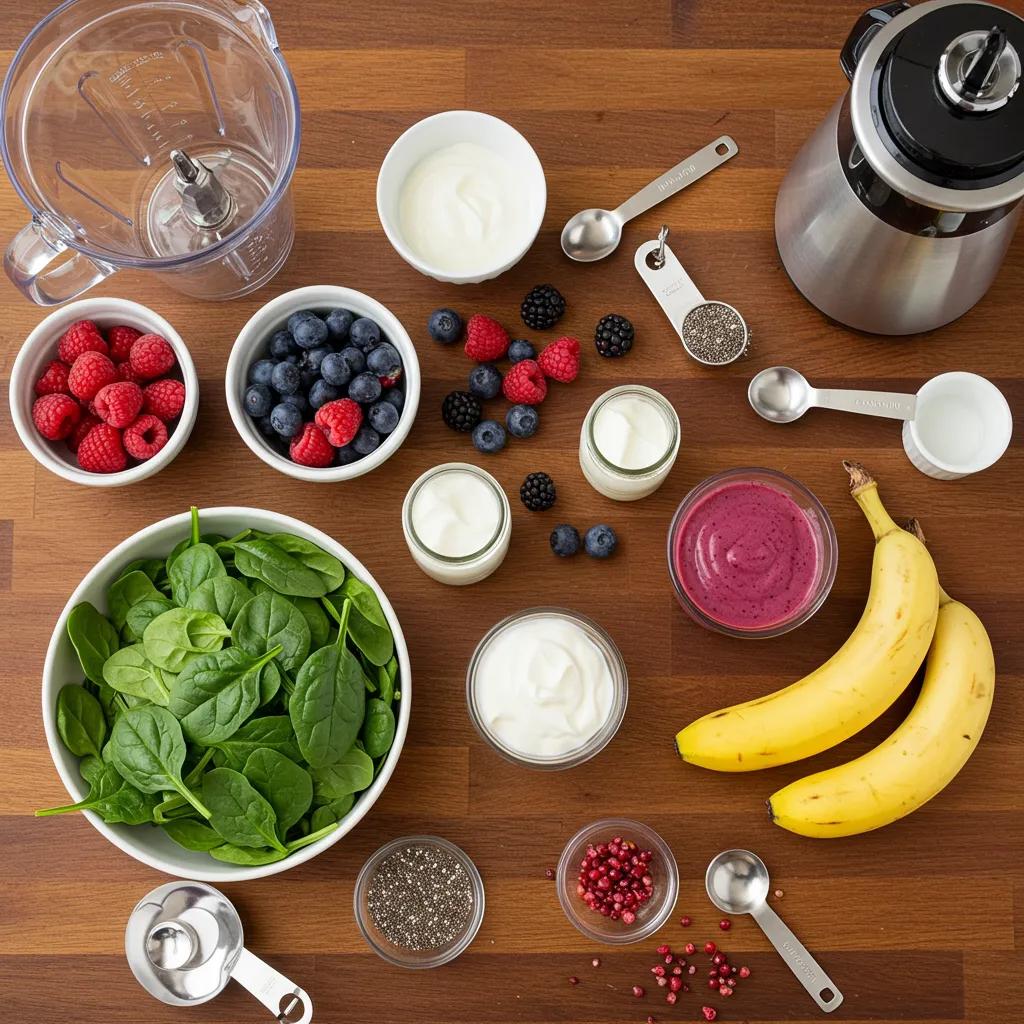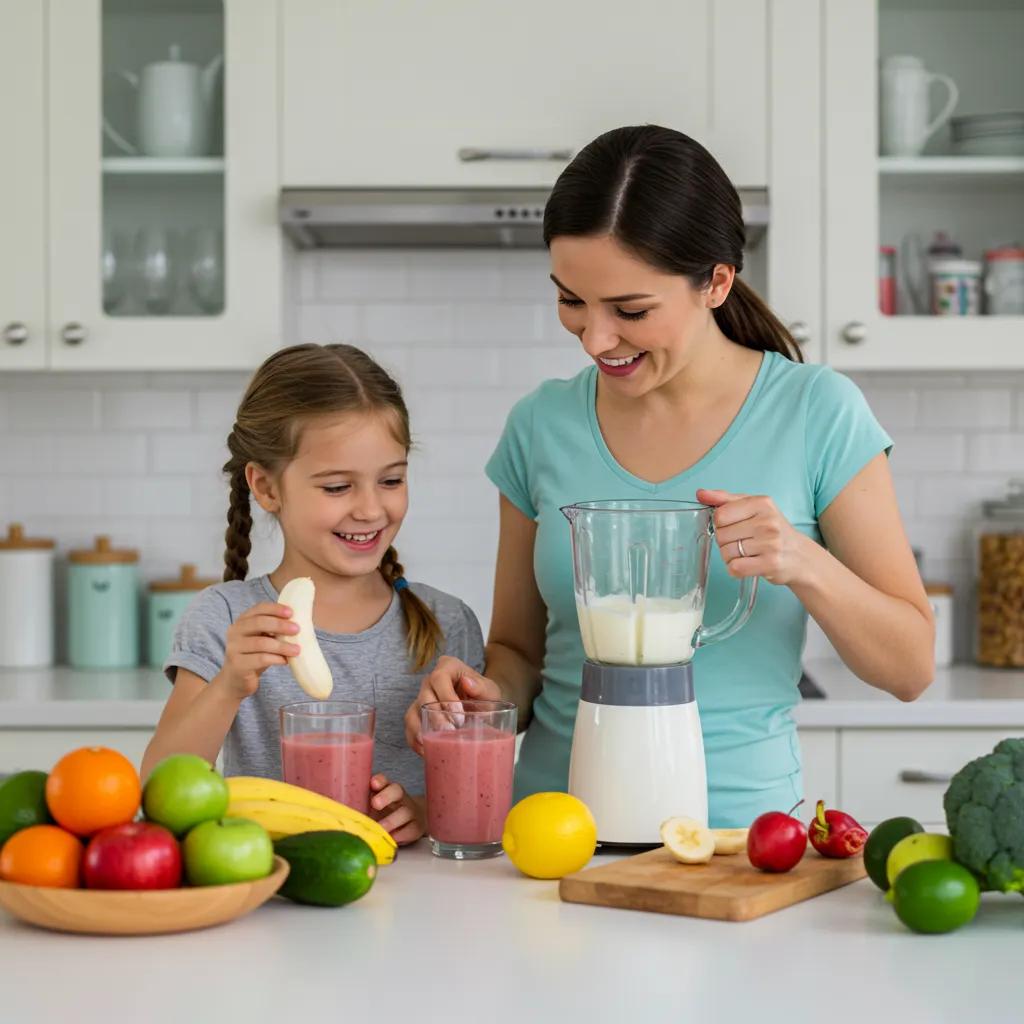Whip Up a Kid-Approved Smoothie with Dr. Adame: Healthy Smoothie Recipes for Children, Approved by a Pediatrician
Dr. Noemi Adame shares her pediatrician-approved, veggie-forward smoothie guidance, helping families transform nutrient-rich whole foods into snacks and mini-meals that kids will actually eat and enjoy. This guide offers practical strategies, the clinical reasoning behind them, and a recipe tested by a clinician, empowering parents to create healthy smoothies that fuel growth, boost immunity, and support brain development. Many families grapple with picky eating, nutrient gaps, and time constraints; evidence-based smoothie building offers a solution by blending taste, texture, and targeted ingredients into a convenient, child-friendly format. You'll discover the 'Veggies Over Pills' philosophy and how it influences ingredient selection, why smoothies are a pediatrician's secret weapon, Dr. Adame's top tips for sneaking in vegetables, a complete Berry Green Power Smoothie recipe with a nutritional breakdown, and how to customize blends for gut, brain, and immune health. Throughout this guide, I'll integrate resources and services from our pediatric practice for families seeking more in-depth support, drawing on pediatrician-led insights into integrative pediatric nutrition and effective behavioral strategies for picky eaters.
What's the 'Veggies Over Pills' Philosophy and How Does It Shape Kid-Friendly Smoothies?
The 'Veggies Over Pills' philosophy champions prioritizing nutrient-dense whole foods and lifestyle choices over medication whenever appropriate, viewing food as a primary tool for promoting children's well-being. This approach works by increasing intake of micronutrients, fiber, and beneficial plant compounds through whole-food selections that aid in prevention and recovery, thereby reducing reliance on treatments that only address symptoms. The outcome is an integrative pediatric nutrition plan designed to nurture the mind, body, and spirit, while still recognizing the importance of clinical judgment when medications or specialized care are necessary. Applying this philosophy to smoothies means crafting blends that emphasize vegetables, healthy fats, protein, and probiotic bases to maximize nutrient density without compromising flavor, supporting both general wellness and specific health goals. smoothies means crafting blends that emphasize vegetables, healthy fats, protein, and probiotic bases to maximize nutrient density without compromising flavor, supporting both general wellness and specific health goals.
How Does the 'Veggies Over Pills' Approach Foster Holistic Child Nutrition?
The 'Veggies Over Pills' approach promotes holistic child nutrition by concentrating on whole-food interventions that deliver a spectrum of vitamins, minerals, fiber, and phytonutrients together, rather than relying on isolated supplements. In essence, whole foods provide complex structures that enhance nutrient absorption and offer synergistic compounds that bolster immunity and brain development. For instance, combining fruits rich in vitamin C with plant-based foods containing iron improves iron uptake, which is crucial for cognitive development and energy levels. This food-first, preventative mindset can reduce the need for medication when suitable and complements evidence-based pediatric care by addressing underlying dietary factors contributing to symptoms.
Why Are Smoothies an Excellent Choice for Delivering Nutrient-Dense Vegetables to Kids?
Smoothies serve as a practical method for delivering vegetables because blending can mask textures, concentrate flavors, and make nutrient-dense foods more palatable and portable for children. Blending can enhance the bioavailability of certain nutrients and allows caregivers to combine multiple food groups—produce, protein, healthy fats, and probiotic bases—into a single, balanced serving. Smoothies also fit seamlessly into daily routines as a breakfast option, a snack, or a post-activity recovery drink, increasing overall exposure to vegetables and fiber. By making vegetables familiar and enjoyable, smoothies support repeated exposure strategies that can gradually reduce picky eating habits.
How Does Dr. Adame Incorporate Integrative Medicine into Smoothie Recipes?
Dr. Adame integrates integrative medicine principles into smoothies by selecting probiotic bases, healthy fats, fiber, and whole-food micronutrient sources tailored to a child's specific needs, while carefully considering allergies and sensitivities. Examples include using kefir or yogurt for probiotic benefits, avocado or chia seeds for omega-rich healthy fats, and leafy greens for iron and folate precursors. Clinical considerations are paramount: dairy-free alternatives are used for milk allergies, nut-free protein options for nut allergies, and gradual introductions for children with sensory sensitivities. This clinician-guided customization balances safety with maximizing the therapeutic advantages of food-based nutrition.
Why Are Smoothies a Pediatrician's Secret Weapon for Healthy Kids?
Smoothies are a pediatrician's secret weapon because they efficiently deliver concentrated nutrients, help bridge nutritional gaps for picky eaters, support hydration, and offer a versatile base for condition-specific additions. Blending allows parents to combine essential vitamins, minerals, fiber, protein, and probiotics into single servings that meet a child's growth and developmental requirements. Pediatricians recommend smoothies as an adaptable tool to fill nutritional voids when whole meals are missed and to introduce "hidden veggie" strategies without escalating mealtime conflicts. The inherent flexibility of smoothies makes them ideal for promoting overall wellness and for targeted interventions to support immune or cognitive function.
What Nutritional Benefits Do Kid-Friendly Smoothies Offer?
Kid-friendly smoothies provide a wealth of macronutrients and micronutrients that support growth, energy levels, and cognitive development by combining fruits, vegetables, protein, healthy fats, and probiotic components. Smoothies can supply vitamin C, vitamin A precursors, folate, iron-enhancing combinations, fiber for gut health, protein for muscle development and neurotransmitter function, and healthy fats crucial for brain development. Practical portioning ensures that smoothies complement, rather than replace, balanced meals; for instance, a blend containing yogurt or milk, fruit, and greens can offer a significant portion of a child's daily calcium, vitamin D (if fortified), and protein needs. The overall benefit is enhanced nutrient density, increased satiety, and consistent nutrient delivery throughout busy days.
Introducing the ingredient-benefit comparison table: This table outlines common smoothie components, their primary nutrient contributions, and their benefits for children, helping parents prioritize ingredient choices.
How Do Smoothies Help Picky Eaters Obtain Essential Nutrients?
Smoothies assist picky eaters by masking the flavors and textures of vegetables with naturally sweet fruits, creamy bases, and appealing colors, all while delivering essential nutrients. Effective strategies include starting with a fruit-dominant profile and gradually increasing the vegetable ratio, concealing greens behind ingredients like banana or berries, and using smooth textures from ingredients like avocado or yogurt to improve mouthfeel. From a behavioral perspective, involving children in ingredient selection and giving the smoothies fun names can boost acceptance and encourage repeated exposure, gradually reducing neophobia over time. Together, these methods help picky eaters expand their dietary variety with minimal fuss.
What Role Do Smoothies Play in Supporting Children's Immune and Brain Health?
Smoothies contribute to immune and brain health by delivering concentrated micronutrients and healthy fats known to positively influence immune responses and neural development. Fruits rich in vitamin C and seeds containing zinc support immune cell function, while plant-based iron sources paired with vitamin C and omega-rich fats from chia or avocado aid cognitive processes and myelination. Regular inclusion of probiotic bases like yogurt or kefir can help maintain a balanced gut microbiome, which plays a role in immune regulation and potentially behavior. Collectively, these nutrients form a food-based strategy to enhance resilience and readiness for learning in children.
What Are Dr. Adame's Top Tips for Crafting Kid-Friendly Vegetable Smoothies?

Dr. Adame's primary recommendations focus on achieving balance: combining controlled sweetness, strategic texture, nutrient density, and child involvement to enhance acceptance and nutritional impact. Parents should aim for a fruit-to-vegetable ratio that gradually shifts towards a higher vegetable content, select creamy bases for optimal texture, and include a source of protein or healthy fat to increase satiety. Practical advice also includes offering small sample portions, making incremental changes, and using positive naming to encourage repeated exposure. These combined tactics respect children's developmental preferences while steadily improving their dietary quality. Get healthy info
Here is Dr. Adame's concise list of practical tips:
Start with Familiar Flavors: Utilize bananas or berries as foundational flavors to effectively mask greens.
Incorporate Protein or Fat: Add yogurt, nut butter, or avocado to enhance satiety and improve texture.
Gradual Vegetable Boosts: Slowly increase the vegetable content over several servings to help palates adjust.
Involve Your Child: Allow children to choose one ingredient to foster autonomy and increase acceptance.
How Can You Balance Sweetness and Texture to Suit Kids' Smoothie Preferences?
Balancing sweetness and texture involves selecting natural sweeteners, carefully managing the fruit-to-vegetable ratio, and adjusting the thickness to a child's preference, ensuring the smoothie is both palatable and not excessively sweet. A practical guideline is to start with approximately a 2:1 ratio of fruit to vegetable by volume and to include a creamy base like yogurt or banana for a smoother consistency. Using ice or frozen fruit can thicken blends without adding sugar, while liquids such as water or milk can thin them to a drinkable consistency. Maintaining this equilibrium helps caregivers reduce added sugars while preserving a pleasant mouthfeel that children will readily accept.
Which Ingredients Are Best for Concealing Vegetables in Smoothies?
The most effective ingredients for hiding vegetables are fruits with strong flavors and creamy binders that mask both color and taste: banana, mixed berries, a small amount of cocoa, and nut butters pair exceptionally well with greens. Berries provide a robust flavor and color-masking effect, while banana offers sweetness and body; nut or seed butters add richness and protein to counteract vegetal notes. For dairy-free options, mashed avocado or coconut yogurt create creamy textures that effectively conceal greens. Strategic pairing and portioning of these ingredients allow parents to increase vegetable content without noticeable changes in flavor.
How Can Parents Involve Children in Smoothie Preparation?

Involving children in smoothie preparation significantly increases their willingness to try them and reduces resistance by assigning age-appropriate tasks, such as selecting a fruit, measuring portions, or pressing the blender button under supervision. For toddlers, offer choices between two ingredients; for school-aged children, invite them to assemble ingredients, rotate tasks, and even name the smoothie. This participation builds familiarity with ingredients, reinforces positive associations, and sparks curiosity about healthy foods. Over time, this involvement fosters a sense of autonomy and helps children become more receptive to whole vegetables in their meals.
What Are the Nutritional Benefits of This Smoothie for Child Development?
The Berry Green Power Smoothie delivers a synergistic blend of macronutrients and micronutrients that support growth, cognitive function, and immune health through whole-food combinations. Vitamin C from berries enhances the absorption of iron from spinach, which is vital for cognitive development and energy levels. Protein from yogurt or kefir aids in neurotransmitter synthesis and muscle repair, while healthy fats from chia seeds or nut butter support myelination and sustained attention. Regular inclusion of this smoothie can help fill common dietary gaps, especially when integrated with balanced meals throughout the day.
What Is Dr. Adame's Pro Tip for Enhancing This Smoothie?
Dr. Adame's pro tip: consider adding a tablespoon of kefir for enhanced probiotic diversity or a small pinch of ground flaxseed for alpha-linolenic acid (when age-appropriate and allergy-safe). These additions can further boost gut and brain-supportive nutrients. Introduce any new additions gradually in small amounts and monitor for tolerance, particularly with probiotics in very young children or those with compromised immune systems. This clinician-informed suggestion enhances the functional benefits while keeping the smoothie palatable and safe for most children.
For families seeking personalized plans or ongoing nutrition guidance, we encourage you to explore the Pediatric Concierge Service for individualized nutrition planning and to schedule longer appointments focused on tailored dietary strategies. Additionally, discover "Get Healthy with Dr. Adame" for more clinician-authored nutrition guidance and recipe inspiration.
How Can You Customize Smoothies to Meet Your Child's Specific Nutritional Needs?
Customizing smoothies involves thoughtfully combining ingredients to target specific goals—such as improving gut health, enhancing brain function, bolstering immune resilience, or accommodating allergies—while carefully considering portion sizes and frequency. Parents should select probiotic bases and sources of soluble fiber for digestive health, pair iron-rich ingredients with vitamin C for cognitive support, and include omega-fat sources for sustained attention. In cases involving complex conditions or neuroimmune issues, clinical pathways and specialized clinics may offer guidance for adaptations. Customization is practical and safe when changes are made incrementally and are medically supervised for children with special health needs.
Introducing the customization matrix: The table below offers a quick reference for ingredient pairings and considerations for common pediatric goals.
Which Ingredient Combinations Boost Gut Health and Digestion?
For optimal gut health, combine probiotic bases with soluble fiber and gentle prebiotic foods: kefir or plain yogurt mixed with banana and oats or chia seeds creates a blend that supports the microbiome. Probiotics introduce beneficial microbial strains, while soluble fibers from oats and chia feed these microbes and promote regular bowel movements. Begin with small portions of probiotics for very young children or those with complex medical histories, and consult a clinician for persistent gastrointestinal symptoms. Serving smoothies between meals can also aid digestion.
What Are the Best Smoothie Additions for Brain-Boosting Nutrition?
Brain-boosting smoothie additions focus on incorporating healthy fats, iron-rich pairings, and sustained-release protein sources: avocado or ground flaxseed provides essential omega fats, nut or seed butters offer protein and magnesium, and spinach combined with vitamin C-rich fruits enhances iron absorption. These combinations are crucial for neurotransmitter production, maintaining neural membrane integrity, and supporting attention spans. Aim for a balanced macronutrient profile to prevent rapid blood sugar spikes and to ensure steady cognitive performance.
How to Adapt Smoothies for Immune Support and Allergy Considerations?
Adapt smoothies for immune support by prioritizing fruits high in vitamin C, seeds containing zinc, and probiotic bases, while carefully managing allergies through substitutions like sunflower seed butter or oat-based yogurts. For children with nut or dairy allergies, opt for seed butters and fortified plant-based probiotic alternatives, and always verify product safety. When immune or neuroimmune conditions are present, collaborate closely with pediatric clinicians or specialized care pathways to ensure dietary changes support clinical goals and do not interfere with ongoing treatments.
Reference for specialized care: For adaptations related to neuroimmune or complex medical cases, the PANS/PANDAS Clinic offers specialized clinical guidance and pathway-informed adjustments when standard approaches require expert input.
Where Can You Find More Holistic Child Nutrition Resources from Culver Pediatrics Center?
How Does the Nurse-Led Wellness Program Support Healthy Eating Habits?
The Nurse-Led Wellness Program emphasizes lifestyle adjustments, coaching, and consistent follow-up to help families establish and maintain healthy eating habits. Nurses provide guidance on portion control, meal planning, behavioral strategies for picky eaters, and monitor progress through regular check-ins. This program is ideal for parents who desire hands-on support in translating clinical recommendations into their daily routines. For ongoing, practical assistance that reinforces pediatrician advice, the Nurse-Led Wellness Program offers structured coaching and accountability.
What Other Nutrition Guides Does Dr. Adame Offer for Families?
Dr. Adame provides clinician-authored content and practical resources designed to reinforce nutrition-first approaches for families, including a regular column and downloadable materials. These resources cover topics such as strategies for incorporating hidden vegetables, foods that support the immune system, and age-appropriate portion guidance to assist parents through various developmental stages. The "Get Healthy with Dr. Adame" content reinforces evidence-based nutrition advice and offers recipe ideas and behavioral techniques grounded in integrative pediatric nutrition. Families can utilize these resources for continuous learning to complement in-clinic consultations.
How Can You Join the PediatricConcierge Service for Personalized Nutrition?
Enrolling in the PediatricConcierge Service provides families with personalized nutrition planning through a Direct Primary Care model, allowing for extended appointment times and direct access to the care team for tailored dietary strategies. Concierge members benefit from individualized attention, more time dedicated to nutrition counseling, and coordinated follow-up to effectively implement personalized plans. For families seeking focused, ongoing nutrition planning and clinician-guided customization, the PediatricConcierge Service offers a direct path to comprehensive, personalized care.
What Are Common Questions About Healthy Smoothies for Kids?
What Fruits and Vegetables Are Best for Kid-Friendly Smoothies?
Top produce choices combine appealing flavors with nutrient density: berries offer vitamin C and antioxidants, bananas provide texture and potassium, spinach contributes folate and iron precursors, and carrots add beta-carotene and natural sweetness. These selections strike a balance between taste and developmental benefits, while minimizing bitter flavors that can deter children. Consider using seasonally available produce to maintain variety and cost-effectiveness.
How Do You Make Smoothies Appealing to Picky Eaters?
Make smoothies appealing through presentation, offering choices, and implementing incremental changes: provide two ingredient options to foster autonomy, use attractive cups or straws, and gradually increase vegetable content over multiple servings. Creatively naming the smoothies and involving children in their preparation enhances acceptance and reduces resistance. Consistent, positive exposure is crucial for shifting food preferences.
What Are the Benefits of Smoothies Compared to Other Snacks?
Smoothies surpass many common snacks by delivering concentrated micronutrients, combining multiple food groups, and providing greater satiety when they include protein and healthy fats. Compared to snacks high in sugar, well-constructed smoothies help prevent rapid blood sugar fluctuations and offer sustained energy. Maintaining portion control and minimizing added sugar are essential to preserve these advantages.
Final list of quick smoothie-building takeaways:
Prioritize whole foods: Focus on vegetables, fruits, protein, healthy fats, and probiotics.
Start familiar, shift gradually: Begin with fruit-forward blends and slowly increase the amount of greens.
Include protein/fat: Essential for satiety and cognitive support.
Involve children: Offering choices and hands-on roles increases acceptance.
These practical takeaways, along with the clinician-informed recipes, equip families to implement vegetable-forward nutrition strategies that align with pediatric integrative care priorities and support healthy child development.

